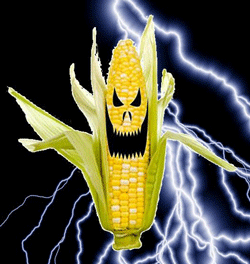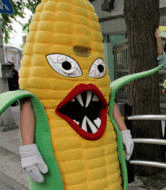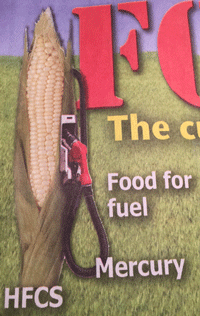This monoculture monster is an environmental disaster
by Michael Braunstein
Online 2015.03.31
A plague is upon us; pestilence abounds; a pox we planted ourselves. Forget locusts. Forget frogs. Forget bird flu, kudzu or African snails. The invasive species strangling, starving and drying up America came all the way from the St. Louis laboratories of Monsanto. It’s corn.
species strangling, starving and drying up America came all the way from the St. Louis laboratories of Monsanto. It’s corn.
The Yellow Peril. Our country is being overrun by corn. It’s the killer crop of the 21st century. How? We got sold a bill of goods — several, it turns out.
It’s a shame because so many hard-working farmers are addicted to corn as a cash crop. But they are financially marginalized by a crop that keeps them on a razor-thin budget while filling the coffers of Big Agriculture. Who’s getting rich? It’s not most farmers so don’t blame them. Corn business was pushed on us by corporate greed and government decree. How many ways can one crop be bad for a people and planet? First, let’s clarify what we’re talking about.
Incredible, inedible corn. If you don’t know by now, there are basically two kinds of corn: field corn and sweet corn. Sweet corn is the kind you boil, roast or grill, drench with butter and enjoy in midsummer. Sweet corn is not the problem (except the new GMO kind.). You have probably never seen a field of edible corn because less than one percent of all corn grown in the United States is edible sweet corn. 99 percent is field corn. Field corn is about as edible as tree bark and has to be radically processed to be of any value to humans. Most field corn is used for animal feed, the other 40 percent goes to ethanol production. The rest goes to high fructose corn syrup, junk food and as a raw material for a variety of products including paints, candles, fireworks, drywall, sandpaper, dyes, crayons, shoe polish, antibiotics and adhesives.
The corn con. Back in the ‘70s, then-Secretary of Agriculture, Earl “Rusty” Butz, hatched a plan to profit corporate agriculture. Butz was a Big Ag crony. He even served on the board of Purina, a huge food conglomerate. By controlling how farmers grew corn, Butz pretty much singlehandedly changed the way farming was done in America. Corporate farms got bigger and Butz’s famous words were “Plant corn from fencerow to fencerow! Get big or get out.”
 Government has always leveraged control over the food system but it grew more insidious with George Bush’s Energy Act of 2005. That turned ethanol production into a gold mine for Big Ag. With government subsidies, tax incentives and blending mandates, ethanol plants cropped up in 16 states, turning corn into inefficient, expensive fuel. In fact, without subsidies from your tax dollars, ethanol would be too expensive to burn in your car. Government and industry propaganda labeled ethanol as a “green” replacement for gasoline. It is anything but. The ways corn kills our planet are many and varied.
Government has always leveraged control over the food system but it grew more insidious with George Bush’s Energy Act of 2005. That turned ethanol production into a gold mine for Big Ag. With government subsidies, tax incentives and blending mandates, ethanol plants cropped up in 16 states, turning corn into inefficient, expensive fuel. In fact, without subsidies from your tax dollars, ethanol would be too expensive to burn in your car. Government and industry propaganda labeled ethanol as a “green” replacement for gasoline. It is anything but. The ways corn kills our planet are many and varied.
Monoculture is bad. Corn prices are sky-high due to subsidized ethanol. “Farmers” plant corn wherever they can. One real farmer I know (he grows food, not corn) wrote that his neighbors are planting corn in the same fields for the fifth, sixth and seventh year in a row. It’s impossible to do that without destroying the topsoil and relying on synthetic fertilizers. Diversity is a good thing in farming just like it is in society. Corn farmers today plant corn year after year, depleting our most valuable natural resource, topsoil.
Ethanol is a disaster. Most corn is used to produce ethanol. The rest is fed to cows and a very small portion is fed to humans in the form of junk food. The government forced ethanol upon us. Big corporations got rich and continue to prosper, propped up by laws that demand we pump corn fuel into our cars and trucks. Meanwhile, ethanol is less efficient than gasoline, damages engines, costs far more to produce, forces farmland prices sky-high, damages the environment, requires more chemicals in farming, depletes the soil and takes away farmland that could be used to grow real food or graze livestock.
The rest is fed to cows and a very small portion is fed to humans in the form of junk food. The government forced ethanol upon us. Big corporations got rich and continue to prosper, propped up by laws that demand we pump corn fuel into our cars and trucks. Meanwhile, ethanol is less efficient than gasoline, damages engines, costs far more to produce, forces farmland prices sky-high, damages the environment, requires more chemicals in farming, depletes the soil and takes away farmland that could be used to grow real food or graze livestock.
The grain required to fill one 25-gallon gas tank with ethanol can feed a person for a year. And ethanol turns out to be dirtier. A UN panel reports, “biofuels emissions — including from land use change — lead to greater total emissions than when using petroleum products.” Other research is confirming that ethanol produces more smog than gasoline. There is nothing green about ethanol.
Sane lawmakers (yes, there are a couple,) are beginning to realize ethanol is a huge mistake and want to end the federal ethanol mandate. The only elected officials who still support laws forcing us to use ethanol are from big corn-producing states like Iowa and Nebraska.
Corn inflates land prices. One organic farmer I know lives on the farm he grew up on in Abie, Neb. He told me he once was able to sit on his porch and see huge stands of cottonwoods in every direction, some he climbed in as a kid. Last year not one tree stood as far as he could see. “They’re pulling up stands of hundred-year-old trees just to plant five, six rows of corn,” he said.
Corn is thirstiest crop. Dr. Loyd Stone at Kansas State shows corn requires more water than wheat, sorghum, milo or soybeans. Nebraska uses more groundwater for ethanol production than does any other state. U. of Iowa professor Jerald Schnoor insists ethanol production is unsustainable, drawing down our water table. He called for halting ethanol expansion.
Corn makes dead zones. Corn is one of the hungriest crops and requires huge amounts of chemical fertilizers. These run off the soil and into rivers and lakes, down to the ocean. A report by the National Academy of Sciences specifically blames runoff from cornfields for record algal blooms in the Great Lakes and the Gulf that kill fish and create dead zones.
Corn kills bees. Corn is wind pollinated so doesn’t need bees. But corn farmers use tons of neonic pesticides and they kill bees. Honeybees are disappearing at epidemic rates. Toxic corn pollen has been found to make up 50 percent of the pollen found in hives.
GMO hotspot. Genetically engineered foods are bad. Close to 100 percent of all corn is GMO. G-M-O spells D-O-O-M.
When it comes to field corn, it’s hard to think of one good thing about it. It wastes water. It wastes soil. It is bad for cows to eat and it makes us fat. “Aw, shucks” isn’t a good answer.
Be well.
